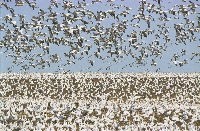
Middle Creek, Courtesy PA Game Commission
|
March winds and snow may still be howling, but a blizzard of another kind is moving in and out of the Pennsylvania Game Commission’s Middle Creek Wildlife Management Area in Lebanon County.
One of the many signs of spring's approach are the arrival of tens of thousands of snow geese at Middle Creek.
Migratory birds such as robins, grackles and blackbirds are returning to Pennsylvania. Now, the snow geese are coming.
This past weekend, an estimated 115,000 snow geese and 4,500 tundra swans were at Middle Creek. The birds can be observed working the fields for food and resting on the large impoundment.
Snow geese migrate north from states south of Pennsylvania to the eastern Arctic region in spring. In the early 1990s, snow geese came to Middle Creek in relatively limited numbers. Then, in 1997, a phenomenal 150,000 snows blanketed the management area's fields and large impoundment, and the birds have been visiting in large numbers pretty much ever since then. The Atlantic Flyway population of snow geese currently numbers about 700,000.
The tundra swan's occupation of Middle Creek parallels that of snow geese. Traditionally, swans leaving their wintering ground further south used to stage on the Susquehanna River, and when they were ready, headed north. Now, Middle Creek has become a migratory staging area that is used each spring by several thousand tundra swans.
Since its creation in the 1970s, Middle Creek, also known as State Game Lands 46, in Lebanon and Lancaster counties just south of Kleinfeltersville, has become a critically important migratory bird stopover and staging area. The 6,000-acre property also contains a 400-acre lake and a wide variety of waterfowl-friendly potholes, ponds and wetlands.
Snow geese weigh six to eight pounds and have a four- to five-foot wingspan. Tundra swans weigh 14 to 18 pounds and have a six- to-seven-foot wingspan. Both species feed on waste grain, winter wheat shoots and grasses, and aquatic vegetation.
On weekends, Middle Creek draws a considerable number of spectators who come to see waterfowl. There are driving routes to follow with plenty of roadside pull-offs, as well as trails to hike. There also are restricted areas where public access is denied. Pending weather and road conditions, the driving routes may be closed.
Visitors planning to see waterfowl up-close should bring a pair of binoculars or a spotting scope. Sometimes the birds will feed quite near roads. If you encounter a bird close to the road, approach slowly and keep noise to a minimum. However, do not go beyond the "no entry" signs.
Visitors should keep in mind that these are estimates and the numbers can change quickly, and the birds also may fly off to feed during the day.
Middle Creek's visitor center, which houses a large wildlife exhibit, is a good first-stop for newcomers. Located just off Hopeland Road near the lake's western shore, the visitor center is staffed and open to the public six days a week. Its schedule is: Tuesdays through Saturdays, 8 a.m. to 4 p.m.; and Sundays, noon to 5 p.m. The center is closed on Mondays.
In addition to snows and tundras, Middle Creek offers other wildlife viewing
opportunities. Canada geese can be found throughout the area. Black ducks, mallards and shovelers cruise the impoundments along with many other ducks. Northern harriers, or marsh hawks, patrol the fields. A pair of bald eagles hang out along the southern shore and eastern end of the lake. Bluebirds also are very busy inspecting roadside bluebird boxes for the upcoming nesting season.
The Game Commission is posting periodic updates about Middle Creek's snow goose and tundra swans numbers on its Watchable Wildlife webpage.
For more tips on seasonal birdwatching around Pennsylvania, visit the Audubon Society chapters directory webpage.
(courtesy of the Pennsylvania Game Commission)
|